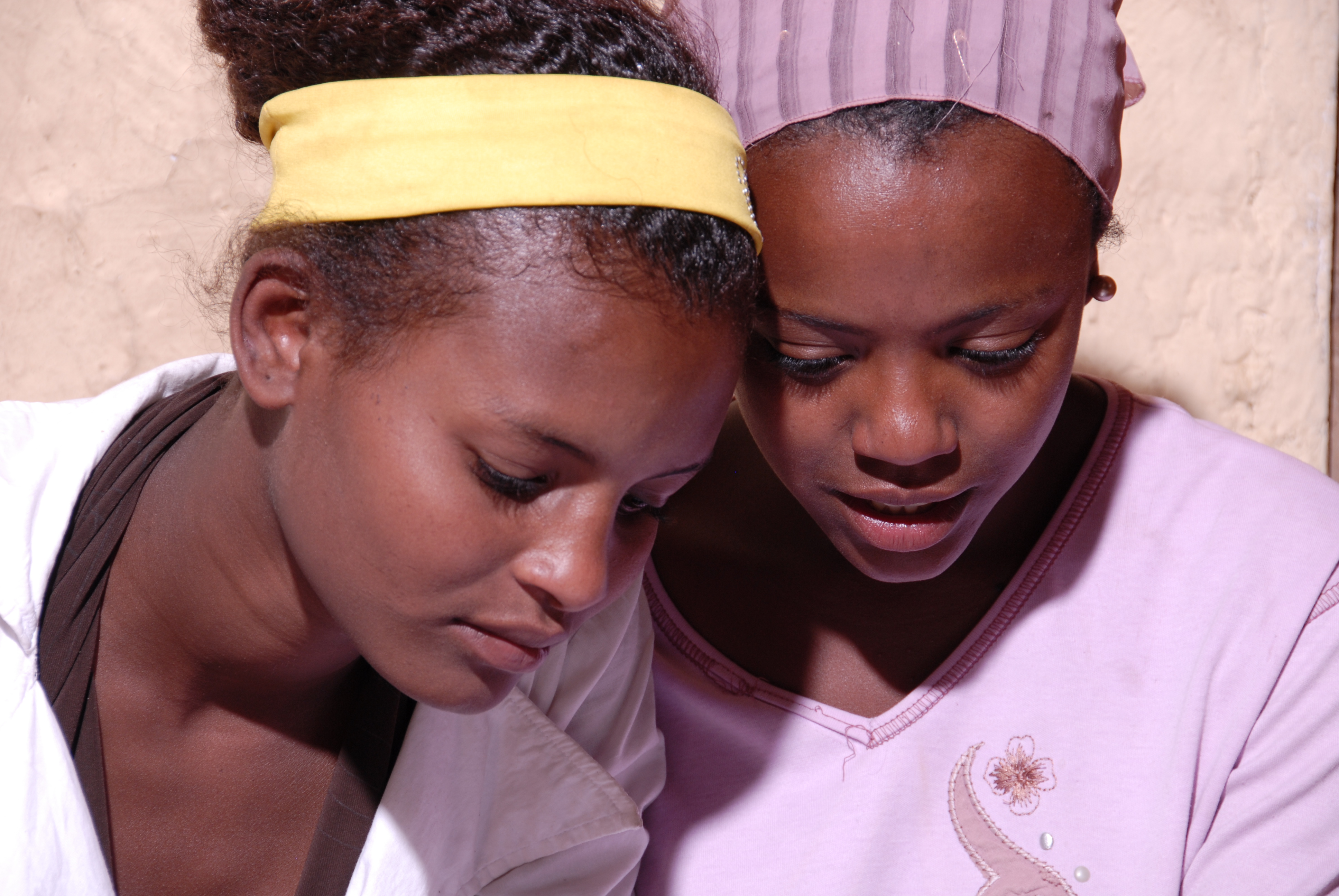
Breadcrumb
At the intersection of childhood and womanhood, adolescent girls are falling through the cracks of violence prevention
This joint blog was co-authored by Kath Ford of Young Lives in collaboration with colleagues from UNICEF Innocenti, GAGE, and the Coalition for Good Schools. It was first published on 23rd November 2022 on the UNICEF (Research - Innocenti) website.
Since the first week after marriage, a problem occurred between us. When I entered the room, I found [my husband] talking to a girl on his laptop. He told me, “Get out… I loved a girl for 15 years and will not forget her.” I asked him, “Why are you talking to women now? You are married now.” He did not allow me to finish talking, he beat me and told me very bad words, his body shook… I told his mother and she said, “This is normal.” I told my father and he said, “This is normal… all men talk on the phone with women and our customs and traditions do not allow divorce…”
Adara, married at age 14 to her 29-year-old cousin, from Jordan
Millions of girls like Adara experience violence every day. Almost a decade ago, UNICEF raised global awareness of the fact that violence was the second leading cause of death of adolescent girls. Since then, evidence and advocacy have established clear targets as part of the Sustainable Development Goals (SDGs) to eliminate gender- and age-based violence, abuse, harmful practices and exploitation, most notably SDGs 5.1, 5.3 and 16.2.
Thirty-three years ago on November 20, the United Nations Convention on the Rights of the Child was signed. Having marked its anniversary last Sunday, it is important to take stock of the progress made in securing the rights of children and to spotlight the significant evidence generated regarding children and adolescents’ experiences of gender-based violence. Yet it is also imperative to acknowledge the ongoing progress that remains to be made in securing these rights.
Gender dimensions of violence in adolescence
Patterns of violence are different for men, women, girls, and boys, and are rooted in prevailing gender norms. While global homicide rates are higher for boys than girls, adolescent girls report higher levels of intimate partner violence (IPV) than boys. Existing at the intersection between “violence against children” and “violence against women”, adolescent girls often fall through the cracks, experiencing forms of violence common to both younger children (e.g. violent discipline) and adults (e.g. IPV).
The World Health Organization estimates that almost 1 in 4 ever married / partnered adolescent girls ages 15-19 have been subjected to physical and/or sexual violence from an intimate partner at least once in their lifetime. The COVID-19 pandemic further increased risk levels of violence against women and girls as a result of heightened household stress and disruptions in violence prevention. Increasing climate disasters and conflict, and related displacement, are exacerbating adolescent girls’ vulnerability.
Violence and education
Violence affects adolescent girls’ ability to access education, including their personal security whilst travelling to and from school, as well as their social and academic performance at school. Experiencing emotional abuse in school, in the form of bullying and sexual harassment, can also have a major impact on the daily lives of children.
Once past puberty, older girls often experience harassment from boys, particularly in countries where persistent discriminatory gender norms prevail.
“We cannot study because we always worry about the boys’ threat. We are frightened always.”
Later, at age 17, Haftey described her relief at having moved closer to her school, “In the past, when I was in the village, children were beating us, waiting for us along the road to our school, but here thanks to God there is no one that beats me.”
Violence against adolescent girls often starts much earlier in life, which has long term impacts. Early childhood exposure to IPV is associated with lower vocabulary and numeracy skills at ages 5 and 8 years. Similarly, teachers’ use of corporal punishment at age 8 is associated with lower maths test scores and a reduction in self-efficacy at age 12. Gender gaps in education outcomes typically widen through adolescence into early adulthood. Girls who drop out of school, especially in rural areas and poorer households, are much more at risk of early marriage than those who stay in education.
Identifying and promoting effective solutions
There has been rapid growth in research on effective prevention and response strategies, though the evidence base remains unevenly distributed across and within countries, with significant gaps in conflict-affected contexts. Promising intervention strategies need to be tested and adapted to a diversity of settings in which violence occurs. To ensure sustained change, broader measures to tackle discriminatory gender norms, poverty, and inequality are also critical.
- Well-designed and implemented parenting support programmes have proven to be effective at reducing violence within the home. The use of positive parenting techniques, warmth and greater consistency in parenting, as well as reduced parental depression and stress, have all been linked to lower levels of violence in the home and improved relationships between parents.
- Early adolescence is a unique window of opportunity for shifting harmful social norms and behaviours. Programmes such as Gender Equity Movement (GEMS) in India and PREPARE in South Africa have engaged young adolescents with a focus on building gender-sensitivity and enabling young people to critically reflect on prevailing gender and violence norms. These programmes recognised the importance of engaging teachers and schools to affect long-standing change in attitudes and behaviours within the community, such as reducing the use of corporal punishment.
- Multi-faceted and culturally relevant school-based interventions implemented over a long period of time have shown potential for sustained impact. It is critical to look beyond the home and the classroom and strive for broader community involvement. A few programmes such as Taaron Ki Toli in (India) and Makani (My Space) in Jordan are starting to engage religious and community leaders, parents, and community organizations among others, to shift community gender norms. The challenge is to identify the key elements within these programmes which make the difference and to scale them up.
- Social assistance programmes (e.g. cash transfers for education and school stipends) have also been found to play a key role in supporting adolescent girls’ education, particularly during the transition from primary to secondary schooling. An example is Zimbabwe’s Harmonised Social Cash Transfer plus initiative which combines unconditional cash for food-poor households with information about child violence prevention and access to social welfare services, which has had a positive effect on physical violence reduction for both girls and boys.
Conclusion
Violence is pervasive – experienced by adolescent girls in all its forms, and across all settings. Its effects are cumulative, disrupting not just their daily lives but also the realization of other rights, to education, to physical and mental health, and to safe transitions into adulthood.
While the effects of violence are devastating, they are preventable. Securing adolescent girls’ rights ensures freedom from violence by promoting bodily integrity for all. Breaking the cycle of violence against children and women requires evidence-based investments and strategies and interventions across sectors, communities, and societies, including at different levels of government, to specifically address the risks that adolescent girls face. Now is the time to accelerate our efforts and multiply our impact.
###
About the authors:
Sarah Alheiwidi is a qualitative researcher with Gender and Adolescence: Global Evidence (GAGE) in Jordan and specialises on adolescent wellbeing, particularly child marriage.
Kath Ford is the Senior Policy Officer at Young Lives, University of Oxford. The Young Lives (YL) longitudinal study has been following the lives of 12,000 young people in Ethiopia, India (in the states of Andhra Pradesh and Telangana), Peru and Vietnam since 2002.
Nicola Jones is a Principal Research Fellow at ODI and is the Director of the Gender and Adolescence: Global Evidence (GAGE) longitudinal research study which is following the lives of 20,000 adolescents in Bangladesh, Ethiopia, Jordan, Lebanon and Nepal from 2016 to 2026.
Shanaaz Mathews is the Director of the Children’s Institute and professor in the Faculty of Health Sciences at University of Cape Town, South Africa and a founding member of the Coalition for Good Schools.
Ramya Subrahmanian is Chief, Child Rights and Protection at UNICEF Innocenti – Global Office of Research and Foresight.

